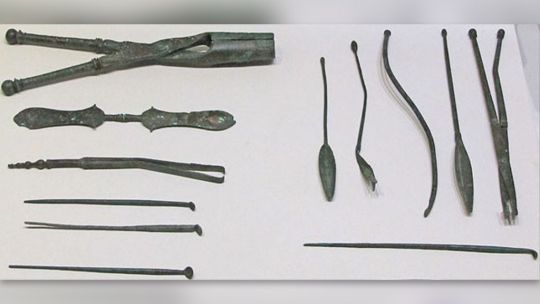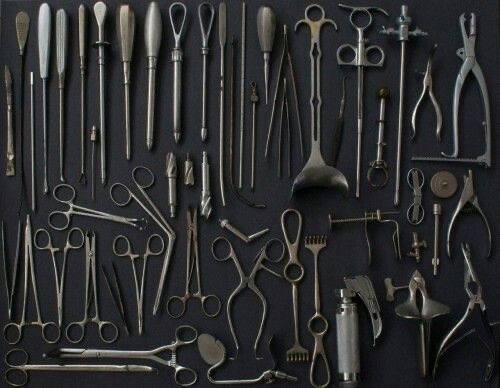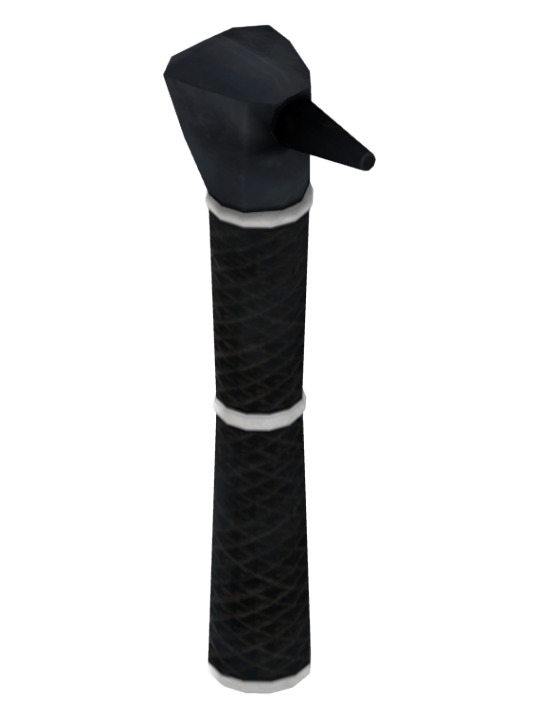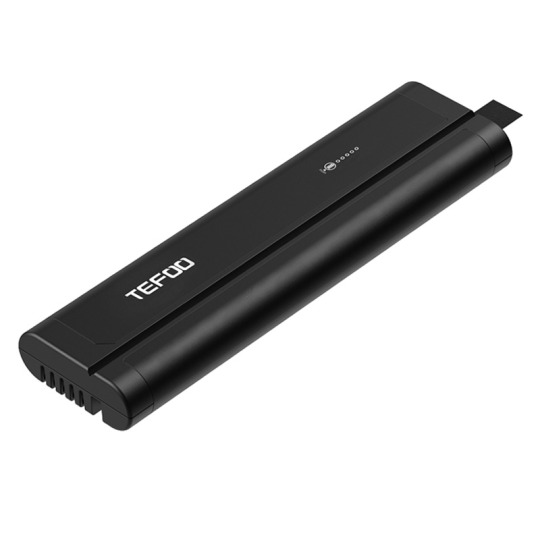#Medical instruments
Text
Nearly 400 ancient medical tools from Turkey hint at rare Roman doctors' offices

Hundreds of Roman-era medical instruments now being examined by scientists may come from one of the earliest known examples of a group medical practice, or at least a place where health care workers congregated to treat people.
A total of 348 artifacts linked to medicine were found at the site of Allianoi, an ancient town that also hosted a large spa-like bath in what is now Turkey. The vast number of the 1,800-year-old artifacts may indicate the site once featured an ancient medical center. The instruments were discovered during rescue excavations that were carried out between 1998 and 2006, before the construction of a dam that flooded the site. Most of the artifacts, which have been studied over the years, were found within two buildings in a larger complex. Read more.
671 notes
·
View notes
Text

117 notes
·
View notes
Text
Why Blunt Filter Needles Are Essential for Precision in Medical Procedures

When it comes to medical procedures, precision is crucial. Every dosage, every injection, and every medication must be accurately administered to ensure the best possible outcomes for patients. This is where syringe filters with blunt needles come in. Blunt filter needles are specialized medical needles designed to enhance precision in medical procedures. In this blog post, we will explore the benefits of using blunt filter needle and their role in achieving precision in medical procedures.
What Are Blunt Filter Needles?
Blunt filter needles are a game-changer in the world of medical procedures. Unlike traditional needles, which have a sharp Blunt-tip, blunt filter needle have a rounded tip that reduces the risk of tissue damage and needlestick injuries. This design not only makes them safer for healthcare professionals to use but also allows for more precise delivery of medications and fluids.
The Need for Precision in Medical Procedures
The precision of medical procedures is vital for various reasons. First, accurate dosages are essential to ensure that patients receive the right amount of medication for their condition. This helps prevent under or overdose, which can lead to complications and delayed recovery.
Additionally, precision in medical procedures reduces medication waste, which can be costly and harmful to the environment. Most importantly, it helps avoid incorrect medication administration, which can have severe consequences for patients.
Read More : Choose the correct Hypodermic needle for your patient
The Role of Blunt Filter Needles in Precision
Blunt filter needle play a crucial role in achieving precision in medical procedures. They are design to work efficiently, ensuring accurate aspiration and injection of medication. This is especially important for procedures that require high accuracy, such as intravenous administration, epidural injections, intramuscular injections, biopsies, and spinal taps. Blunt filter needle also make it easier for medical professionals to handle and administer medication, reducing the risk of errors.
How to Choose the Right Blunt Filter Needle
When it comes to choosing the right blunt filter needle, there are a few factors to consider. First, the needle size and gauge should be suitable for the intended use. Different procedures may require different needle sizes and gauges, so it is essential to consult a medical professional for guidance. Additionally, the needle must be compatible with the syringe being used. Lastly, it is crucial to ensure that the blunt filter needle has quality and safety certifications to guarantee its efficacy and compliance with regulations.
Benefits of Blunt Filter Needles
Blunt filter needles have many benefits that make them an essential tool in medical settings. First and foremost, they prevent accidental needle sticks. This is especially important for medical professionals who handle syringes and needles daily. Blunt filter needle also reduce needle breakage, which can lead to medication waste and increase the risk of complications. Additionally, these needles minimize tissue damage, resulting in less pain and discomfort for patients.
Moreover, blunt filter needle ensure accurate medication delivery. With their design, they can aspirate and inject with precision, decreasing the chances of incorrect dosages. This also leads to improved patient comfort as medication is delivered directly to the intended site.
Applications of Blunt Filter Needles in Medical Procedures
Many medical procedures require precision, and blunt filter needle are a valuable tool in achieving it. Some of these procedures include intravenous (IV) administration, where accurate dosages are crucial for proper medication absorption and delivery. Epidural injections, which are use to manage pain, also require precision to avoid complications. Similarly, intramuscular injections, biopsies, and spinal taps all need accurate medication delivery for the best outcomes.
Conclusion
In conclusion, blunt filter needles are an essential tool in achieving precision in medical procedures. Their benefits, such as preventing needle sticks, reducing breakage, and improving accuracy, make them a valuable addition to any medical setting. As a patient, it is essential to discuss with your healthcare provider the use of blunt filter needles for your medical procedures. With the right blunt filter needle, you can rest assured that your medical procedures will be performed with the utmost precision for the best possible outcomes.
Source : Why Blunt Filter Needles Are Essential for Precision in Medical Procedures
#Blunt Filter Needles#Medical Accuracy#Needle Safety#Safe Needle Usage#Medical Instruments#Medical Essentials#Precision Matters#Safe Needles#Healthcare
2 notes
·
View notes
Text
www.cn-hospitalbed.com
#medical instruments#Toilet Safety Rails#Mobility Aids#Bathroom Assistive Devices#Toilet Grab Bars#Bathroom Safety Equipment#Mobility Support Tools#Restroom Handrails#Accessibility Aids#Commode Aids#medical bed#medical hospital furniture#exporter&importer
3 notes
·
View notes
Text
National Museum of Health and Medicine in Silver Spring, Maryland. The rocking chair is the chair Lincoln was sitting in when he was assassinated.










#walter reed#walter reed museum#walter reed medical museum#abraham lincoln#lincoln#assassination#medical oddities#medical instruments#iron lung#skeletons#skeleton#oddities#national museum of health and medicine
14 notes
·
View notes
Text

Pictured: An ophthalmoscope from Fallout 3.
You can read more about ophthalmoscopes here
#Fallout#Fallout 3#ophthalmoscope#ophthalmoscopy#ophthalmology#ophthalmologist#Can you tell I learned a new word?#fallout wiki#medical instruments#tw
10 notes
·
View notes
Text


[2022] Sehnsucht (longing)
Final mixed media drawing assignment from last semester 🦷 watercolor, acrylic, pen, markers, paper scraps, metal and colored pencil
#yes its inspired by rammstein's album of the same name!#my art#school stuff#original work#mixed media#mmmm#suggestive#i guess#bandages#medical instruments
6 notes
·
View notes
Text
Know Some Basic Information About Data Loggers
Data collection and storage have become considerably faster, simpler, and far more effective as a result of technological improvements. Data loggers are one such improvement. It is a data storage device. These particular devices collect information by reading a variety of electronic signals and storing data in internal memory, which may subsequently be transferred to a computer as necessary. They come in a variety of forms and sizes.
This could include functions like soil moisture threshold recording, road traffic going to count, tank level tracking, environmental management, wildlife study, fuel gas tracking, vehicle testing like rail line signals, temperature data recording, monitoring the particular temperature, automatic monitoring, hydrology recording, tracking shipping temperatures, as well as monitoring the vibrant shipment package vibrations. Temperature and humidity data logger will always help you out.
2 notes
·
View notes
Text
Why do medical equipment batteries use lithium batteries?
Lithium battery is a kind of battery that uses lithium metal or lithium alloy as negative electrode material and uses non-aqueous electrolyte solution. Lithium batteries can be roughly divided into two categories: lithium metal batteries and lithium ion batteries. Lithium-ion batteries do not contain lithium in the metallic state and are rechargeable. Due to the very active chemical properties of lithium metal, the processing, storage and use of lithium metal have very high environmental requirements. Therefore, lithium batteries have not been used for a long time. Lithium batteries have now become mainstream.

Performance characteristics of lithium batteries:
Long service life, the service life can reach more than 6 years, the battery with lithium iron phosphate as the positive electrode is charged and discharged with 1CDOD, and there is a record of 10,000 times of use;
The specific energy is relatively high. It has high storage density, which has reached 460-600Wh/kg, which is about 6-7 times that of lead-acid batteries;
With high power tolerance, the lithium iron phosphate lithium ion battery for electric vehicles can reach 15-30C charge and discharge capacity, which is convenient for high-intensity startup acceleration;
The rated voltage is high (the single working voltage is 3.7V or 3.2V), which is approximately equal to the series voltage of 3 nickel-cadmium or nickel-hydrogen rechargeable batteries, which is convenient to form a battery power pack;
Light weight, the weight is about 1/5-6 of lead-acid products under the same volume;
The production basically does not consume water, which is very beneficial to my country, which is short of water.
High and low temperature adaptability, can be used in the environment of -20℃--60℃, and can be used in the environment of -45℃ after technical treatment;
Lithium batteries have excellent performance, long life, and safe use, with an energy density of up to 7,000 kilowatts per kilogram (W). And compared with other batteries, its use cost is lower. However, the high temperature of medical equipment and the environment, and the harsh use conditions put forward more stringent requirements on the performance of lithium batteries, which requires the lithium batteries of medical equipment to be further improved in terms of safety and durability, strong capacity release capability, and long service life. So now medical equipment uses lithium batteries.
E-Mail:[email protected]
Technical Support:[email protected]
Website:efoo-energy.com
Official shop:
5 notes
·
View notes
Text

New heart ❤️
Althea belongs to me sonicdragonfan
Sorry for the bad angle drawing on skinny paper
#undertale sketch#witch#medicine witch#surgery#heart surgery#child patient#general surgeon#mature#medical instruments
0 notes
Text
Welch Allyn CP150 12-Lead Interpretive ECG | AMA Products

The Welch Allyn CP150 is a high-performance 12-lead ECG machine designed for accuracy and ease of use. It features interpretive analysis to assist with quick and reliable diagnosis, making it ideal for both clinical and office settings.
With a user-friendly interface and compact design, it offers precise readings and seamless integration into your healthcare practice. Enhance your diagnostic capabilities with this essential medical equipment.
#equipment#medical equipment#lab equipment#scientific equipment#heavy equipment#healthcare equipment#diagnostic devices#healthcare products#hospital equipment#medical instruments#welch allyn electrocardiograph
0 notes
Text

0 notes
Text
The Quincke Tip Spinal Needle: Key Features Explained

Spinal procedures are critical interventions that demand precision, expertise, and the right tools. Among these tools, the Quincke tip spinal needle holds a pivotal role. Understanding the anatomy of the Quincke tip spinal needle and its significance can enhance procedural outcomes and patient safety. In this comprehensive guide, we delve into the structure, benefits, and applications of the Quincke tip spinal needle, emphasizing its importance in spinal procedures.
What is the Quincke Tip Spinal Needle?
The Quincke tip spinal needle, named after German internist Heinrich Quincke, is a medical instrument design for lumbar punctures and spinal anesthesia. Its distinctive feature is the cutting bevel tip, which facilitates penetration through the dura mater. This needle is widely use due to its efficiency in providing access to the subarachnoid space.
Anatomy of the Quincke Tip Spinal Needle
The spinal needle is meticulously design to optimize its functionality. Here are the key components:

Quincke Bevel Spinal Needle
1. Bevel Tip
The most notable feature of the Quincke tip spinal needles is its bevel tip. The cutting edge of the bevel tip allows for smooth penetration through tissues. This design reduces the risk of deflection and ensures accurate needle placement.
2. Shaft
The shaft of the spinal needle is typically made of stainless steel, providing durability and resistance to bending. The shaft’s diameter and length vary based on the specific application and patient anatomy.
3. Hub
The hub of the needle is where the shaft is connected to the syringe or other medical apparatus. It is design for a secure fit, ensuring stability during the procedure.
4. Stylet
The surgeon inserts the removable component, the stylet, into the shaft of the needle. It prevents tissue from clogging the needle during insertion. Once the healthcare provider properly positions the needle, they remove the stylet to allow fluid withdrawal or drug administration.
Why the Quincke Tip Matters in Spinal Procedures
The needle is integral to the success of various spinal procedures. Here’s why it matters:
1. Precision in Needle Placement
The cutting bevel tip of the Quincke needle ensures precise placement, which is crucial for effective lumbar punctures and spinal anesthesia. Accurate needle placement reduces the risk of complications and enhances the effectiveness of the procedure.
2. Minimized Tissue Damage
The design of the Quincke tip minimizes tissue trauma. Its sharp bevel tip allows for a clean cut through the dura mater, reducing the likelihood of post-procedural headaches and other complications associated with tissue damage.
3. Versatility
The Quincke tip spinal needle is versatile and used in various spinal procedures, including diagnostic lumbar punctures, spinal anesthesia, and intrathecal drug delivery. Its adaptability makes it a preferred choice among healthcare professionals.
Read More About : Comparative Analysis of Spinal Needle Sizes
4. Enhanced Patient Safety
The precise design and functionality of the Quincke needle contribute to patient safety. By minimizing tissue damage and ensuring accurate needle placement, healthcare professionals significantly reduce the risk of adverse effects.
Applications of the Quincke Tip Spinal Needle
1. Lumbar Punctures
Lumbar punctures, also known as spinal taps, involve extracting cerebrospinal fluid (CSF) for diagnostic purposes. The sharp bevel tip ensures efficient and safe access to the subarachnoid space.
2. Spinal Anesthesia
Spinal anesthesia requires precise administration of anesthetic agents into the subarachnoid space. The needles design facilitates accurate delivery, ensuring effective anesthesia with minimal complications.
3. Intrathecal Drug Delivery
For patients who need long-term management of chronic pain or spasticity, healthcare providers often utilize intrathecal drug delivery. The Quincke needle ensures the precise placement of catheters for continuous drug infusion.
Choosing the Right Quincke Tip Spinal Needle
When selecting a Quincke tip spinal needle, several factors should be consider:
1. Needle Gauge
The gauge of the needle determines its diameter. Thinner needles (higher gauge) reduce patient discomfort and the risk of post-procedural headaches but may be more challenging to maneuver. Common gauges for spinal needles range from 22 to 27.
2. Needle Length
Choose the needle length based on the patient’s body habitus and the specific procedural requirements. Standard lengths range from 3.5 inches to 5 inches.
3. Material
Manufacturers make most spinal needles from stainless steel due to its durability and resistance to corrosion. However, some needles may have coatings to enhance smoothness and reduce friction.
Tips for Effective Use of Quincke Tip Spinal Needles
To maximize the effectiveness and safety of spinal needles, consider the following tips:
1. Proper Positioning
Ensure the patient is in the correct position to facilitate needle insertion. Common positions include the lateral decubitus position and the sitting position with flexed spine.
2. Aseptic Technique
Maintain strict aseptic technique to prevent infections. This includes proper hand hygiene, using sterile gloves, and disinfecting the puncture site.
3. Slow Insertion
Insert the needle slowly and steadily to reduce the risk of deflection and ensure accurate placement. Avoid sudden movements that could cause tissue damage.
4. Patient Communication
Communicate with the patient throughout the procedure to monitor their comfort and promptly address any concerns.
Conclusion
The Quincke tip spinal needle remains a cornerstone in spinal procedures due to its precise design and effectiveness. Understanding its anatomy and applications can enhance procedural success and patient outcomes. By selecting the appropriate needle gauge, length, and adhering to best practices, healthcare professionals can optimize the use of the Quincke tip spinal needle in various clinical scenarios.
Source :The Quincke Tip Spinal Needle: Key Features Explained
#Spinal Needle#Quincke Needle#Medical Devices#Needle Innovation#Medical Instruments#Surgical Equipment
0 notes
Text
Top Medical Instrument Suppliers in Chennai - Quality Equipment
Discover reliable medical instrument suppliers in Chennai offering a wide range of high-quality equipment. Find surgical tools, diagnostic devices, and more from trusted suppliers in Chennai.
0 notes
Text

01/06/2011
0 notes
Text
1 note
·
View note